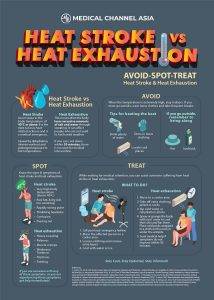As summer approaches and temperatures begin to rise, it’s important to be aware of the dangers of heat-related illnesses. Two common heat-related illnesses are heat stroke and heat exhaustion.
While they share some similarities, they are different conditions with distinct symptoms and treatments.

Heat exhaustion is a condition that occurs when the body becomes overheated and dehydrated. It typically happens when someone has been exposed to high temperatures and/or high humidity for an extended period of time. Symptoms of heat exhaustion may include:
- Heavy sweating
- Fatigue
- Dizziness or lightheadedness
- Nausea or vomiting
- Headache
- Weakness
- Muscle cramps
If left untreated, heat exhaustion can progress to heat stroke, which is a more serious condition. Heat stroke occurs when the body’s internal temperature reaches 104 degrees Fahrenheit or higher. It can be life-threatening and requires immediate medical attention. Symptoms of heat stroke may include:
- Hot, dry skin
- Rapid pulse
- Rapid, shallow breathing
- High fever
- Confusion or disorientation
- Seizures
- Loss of consciousness
Heat stroke is a medical emergency, and anyone experiencing symptoms should seek medical attention immediately. In the meantime, it’s important to take steps to cool the person down, such as moving them to a shaded or air-conditioned area, removing excess clothing, and applying cool water or ice packs to their skin. Preventing heat-related illnesses is key. Here are some tips for staying safe in hot weather:
- Drink plenty of water and other fluids, even if you don’t feel thirsty.
- Avoid caffeine and alcohol, which can dehydrate you.
- Wear loose, lightweight clothing and a hat to protect yourself from the sun.
- Take frequent breaks in the shade or in air-conditioned areas.
- Avoid strenuous activity during the hottest parts of the day.
- Check on elderly or vulnerable individuals who may be at higher risk of heat-related illnesses.
Assisting someone experiencing Heat Stroke or Heat Exhaustion
While waiting for medical professionals, you can assist someone experiencing heat stroke or heat exhaustion.
Heat Stroke
- Call your local emergency hotline
- Move the affected person to a cooler area
- Loosen clothing and remove extra layers
- Cool with water or ice
Heat Exhaustion
- Move to a cooler area
- Take off extra clothing, jackets or socks
- Sip cold water or rehydration drinks
- Spray or sponge the body with cool water to cool their skin and fan them. Place cold packs wrapped in a cloth on the neck or under the armpits.
- Seek medical help if the symptoms do not improve within 30 minutes
In summary, heat exhaustion and heat stroke are both heat-related illnesses that can occur when the body becomes overheated and dehydrated. Heat exhaustion is a milder condition that can progress to heat stroke if left untreated. Heat stroke is a serious medical emergency that requires immediate attention. The best way to prevent heat-related illnesses is to stay hydrated, avoid strenuous activity during the hottest parts of the day, and take breaks in the shade or in air-conditioned areas.
Remember, prevention is key. Stay hydrated, take frequent breaks in cool areas, and avoid strenuous activity during the hottest parts of the day to prevent heat-related illnesses.

